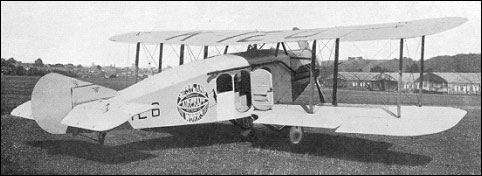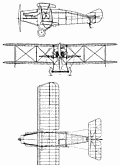 |
Westland Limousine 4 Seat1919 |  |
| FOUR-SEAT COMMERCIAL BIPLANE | Virtual Aircraft Museum / United Kingdom / Westland |
 |
Immediately after the signing of the Armistice, in November 1918, Mr. Bruce and Mr. Davenport directed their accumulated design experience into more peaceful channels and produced, in the summer of 1919, the first Westland commercial aircraft. This machine was the four-seat Limousine, and was one of the first efforts to introduce an element of luxury to flying, the well-ventilated and upholstered cabin being comparable to the accommodation of the most expensive motor-cars, while the running costs of its 275hp Rolls Royce Falcon engine made it an attractive proposition to air-line operators and business executives. The Limousine, unfortunately, suffered from having been introduced at a time when public interest in air travel was almost a minus quantity and, although a few were constructed, Westland activity was soon switched to the design of a larger version, the Six-seat Limousine, which seemed to offer better prospects. The original Limousine, however, created tremendous interest in the aeronautical world and a demonstration of its commercial possibilities, in which one of the company's directors, Mr. R. J. Norton, dictated letters to his secretary, Miss Stanfield, and had them typed while in flight, was widely publicised. The handling qualities of the Limousine were once ably demonstrated by Captain Keep during a cross-country flight, with an Air Ministry official and Miss Jean Bruce as passengers. While flying over the Dorset Hills they noticed, in a field below, an extraordinarily large crop of mushrooms and, without further ado, Captain Keep made a landing in the field, a rugful of mushrooms was gathered and the flight resumed with the greatest ease ! Of the Limousines produced, one was used in Newfoundland by Mr. Sidney Cotton, while the original model had a long period of useful service as the Westland communication machine, the latter being finally written off in a remarkable accident at Netheravon. Major Openshaw had flown Mr. Bruce to the R.A.F. Station there on business, and they had just parked the Limousine in a "safe" space, on the aerodrome, when the outer machine of a flight of R.A.F. Fairey Fawn biplanes, then taking off, collided with the rear fuselage. The resulting crash was quite spectacular, wreckage being scattered over a considerable area and no part of the R.A.F. machine's remains was more than two or three feet above the level of the grass. The amazing feature, however, was that the Service pilot and his observer were quite unharmed! A.H.Lukins "The Book of Westland Aircraft", 1943
|  COMPANY PROFILE | |||||||||||||||||||||||||||||||||||||||||||||||||
 |

|


